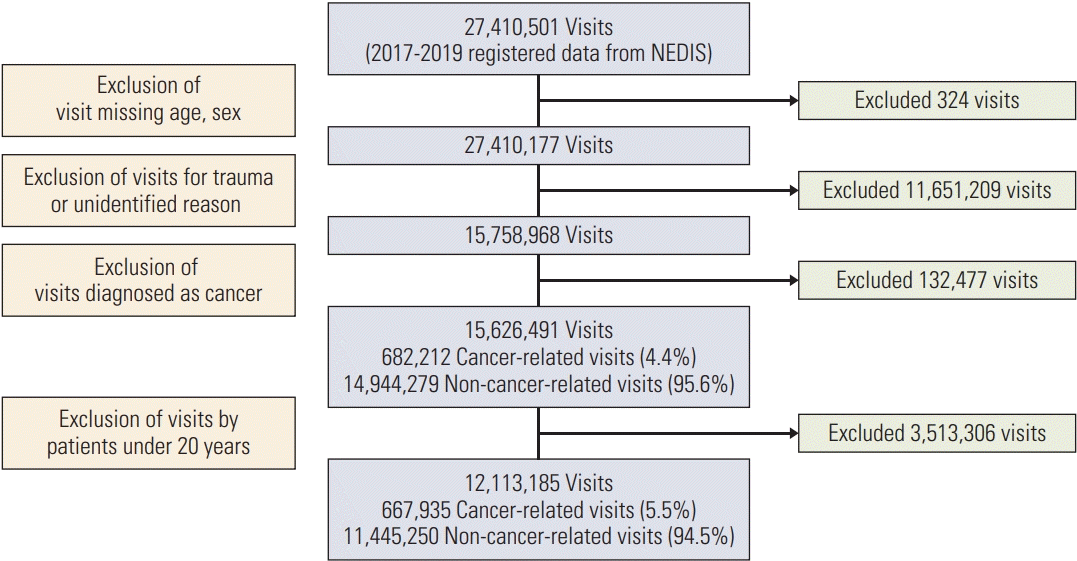1. Rivera DR, Gallicchio L, Brown J, Liu B, Kyriacou DN, Shelburne N. Trends in adult cancer-related emergency department utilization: an analysis of data from the nationwide emergency department sample. JAMA Oncol. 2017; 3:e172450.
2. Hsu J, Donnelly JP, Moore JX, Meneses K, Williams G, Wang HE. National characteristics of emergency department visits by patients with cancer in the United States. Am J Emerg Med. 2018; 36:2038–43.

3. Caterino JM, Adler D, Durham DD, Yeung SJ, Hudson MF, Bastani A, et al. Analysis of diagnoses, symptoms, medications, and admissions among patients with cancer presenting to emergency departments. JAMA Netw Open. 2019; 2:e190979.

4. Scholer AJ, Mahmoud OM, Ghosh D, Schwartzman J, Farooq M, Cabrera J, et al. Improving cancer patient emergency room utilization: a New Jersey state assessment. Cancer Epidemiol. 2017; 51:15–22.

5. Wong TH, Lau ZY, Ong WS, Tan KB, Wong YJ, Farid M, et al. Cancer patients as frequent attenders in emergency departments: a national cohort study. Cancer Med. 2018; 7:4434–46.

6. Dufton PH, Drosdowsky A, Gerdtz MF, Krishnasamy M. Socio-demographic and disease related characteristics associated with unplanned emergency department visits by cancer patients: a retrospective cohort study. BMC Health Serv Res. 2019; 19:647.

7. Mayer DK, Travers D, Wyss A, Leak A, Waller A. Why do patients with cancer visit emergency departments? Results of a 2008 population study in North Carolina. J Clin Oncol. 2011; 29:2683–8.

8. Jung M. Research on the actual conditions of cancer patients in the emergency room in a university hospital in Seoul. Seoul: The Graduate School of Information in Clinical Nursing, Hanyang University;2009.
9. Shin TG, Song JW, Song HG, Hong CK. Characteristics of frequent users of emergency department. J Korean Soc Emerg Med. 2011; 22:86–92.
10. Sung HK, Paik JH, Lee YJ, Kang S. Impact of the COVID-19 outbreak on emergency care utilization in patients with acute myocardial infarction: a nationwide population-based study. J Korean Med Sci. 2021; 36:e111.

11. Ryu JH, Min MK, Lee DS, Yeom SR, Lee SH, Wang IJ, et al. Changes in relative importance of the 5-level triage system, Korean Triage and Acuity Scale, for the disposition of emergency patients induced by forced reduction in its level number: a multi-center registry-based retrospective cohort study. J Korean Med Sci. 2019; 34:e114.

12. Liew D, Liew D, Kennedy MP. Emergency department length of stay independently predicts excess inpatient length of stay. Med J Aust. 2003; 179:524–6.

13. Warren MB, Campbell RL, Nestler DM, Pasupathy KS, Lohse CM, Koch KA, et al. Prolonged length of stay in ED psychiatric patients: a multivariable predictive model. Am J Emerg Med. 2016; 34:133–9.

14. Peyrony O, Fontaine JP, Beaune S, Khoury A, Truchot J, Balen F, et al. EPICANCER-cancer patients presenting to the emergency departments in France: a prospective nationwide study. J Clin Med. 2020; 9:1505.

15. Lee J. A study on the characteristics of cancer patients in emergency center. Seoul: The Graduate School, Chung-Ang University;2018.
16. Ha BH, Park JY. Triage and length of stay in a cancer center emergency department. Asian Oncol Nurs. 2017; 17:246–51.

17. Philip J, Remedios C, Breen S, Weiland T, Willenberg L, Boughey M, et al. The experiences of patients with advanced cancer and caregivers presenting to emergency departments: a qualitative study. Palliat Med. 2018; 32:439–46.

18. Diaz-Couselo FA, O’Connor JM, Nervo A, Tossen G, Guercovich A, Puparelli C, et al. Non-scheduled consultation in oncologic patients. How many of them are true emergencies? An observational prospective study. Support Care Cancer. 2004; 12:274–7.

19. Aprile G, Pisa FE, Follador A, Foltran L, De Pauli F, Mazzer M, et al. Unplanned presentations of cancer outpatients: a retrospective cohort study. Support Care Cancer. 2013; 21:397–404.

20. Ahn S, Lee YS, Lim KS, Lee JL. Emergency department cancer unit and management of oncologic emergencies: experience in Asan Medical Center. Support Care Cancer. 2012; 20:2205–10.

21. Hong AS, Froehlich T, Clayton Hobbs S, Lee SJC, Halm EA. Impact of a cancer urgent care clinic on regional emergency department visits. J Oncol Pract. 2019; 15:e501–9.





 PDF
PDF Citation
Citation Print
Print




 XML Download
XML Download